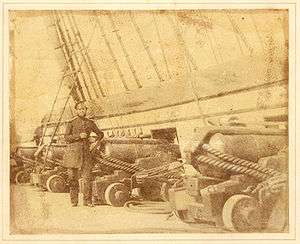HMS Superb (1842)
 An officer on board HMS Superb, 1845. | |
| History | |
|---|---|
| Name: | HMS Superb |
| Builder: | Pembroke Dockyard |
| Laid down: | November 1838 |
| Launched: | 6 September 1842 |
| Fate: | Broken up, 1869 |
| General characteristics [1] | |
| Class and type: | Vanguard-class ship of the line |
| Tons burthen: | 2583 bm |
| Length: | 190 ft (58 m) (gundeck) |
| Beam: | 56 ft 9 in (17.30 m) |
| Depth of hold: | 22 ft 6 in (6.86 m) |
| Propulsion: | Sails |
| Sail plan: | Full rigged ship |
| Armament: |
|
HMS Superb was a two-deck 80-gun second rate ship of the line of the Royal Navy, launched on 6 September 1842 at Pembroke Dockyard.[1]
She was one of the Vanguard class, designed by Sir William Symonds, Surveyor of the Navy and an innovative and controversial naval architect. Each ship of the class was designed with a slightly different hull shape, aiming to optimise speed and handling characteristics. After Commissioning, Superb joined the Channel Fleet under the command of Captain Armar Lowry Corry. In February 1845, she joined the Experimental Squadron of eight ships, four of them built by Symonds. They engaged in three competitive cruises to test Symonds’ new hull designs against older, traditionally built warships. The whole Squadron was reviewed by Queen Victoria and Prince Albert at Spithead on 22 June and the trials were completed by December, Superb having proved to be the fastest ship in the last cruise. Overall, the results were inconclusive and became mired by political wrangling and professional rivalry, with the result that Symonds resigned. Superb took part in further trials the following year with yet more ships, this time called The Squadron of Evolution. The whole project was made irrelevant by the advent of steam propulsion and the Vanguard class were some of the last major Royal Navy warships to rely solely on sail propulsion.[2]
Returning to duties with the Channel Fleet, she saw action in the Portuguese “Little Civil War” or Patuleia in 1847, as part of a British squadron commanded by Sir William Parker, which was sent to support Queen Maria II. In May, a division of rebel troops commanded by the Conde das Antas was being ferried by sea along the coast, with the aim of securing the mouth of the River Tagus, thus blockading the capital. The convoy was intercepted by the British squadron and ordered to surrender. When Antas refused, boats’ crews put off from the British warships and boarded and captured all the transports, despite coming under fire from coastal batteries. Some three thousand rebel soldiers were disarmed and held in Fort St Julian under a guard of Royal Marines until relieved by loyal Portuguese troops.[3]
In November 1848, the Superb under Captain Edward Purcell joined the Mediterranean Fleet, and continued there until paying off into the reserve at Chatham in June 1852.[4]
Superb was broken up in 1869.[1]
Notes
- 1 2 3 Lavery, Ships of the Line vol.1, p191.
- ↑ http://www.pdavis.nl/Experimental1845.php
- ↑ "Globe and Laurel" August 1893
- ↑ .http://www.pdavis.nl/ShowShip.php?id=2135
References
- Lavery, Brian (2003) The Ship of the Line - Volume 1: The development of the battlefleet 1650-1850. Conway Maritime Press. ISBN 0-85177-252-8.